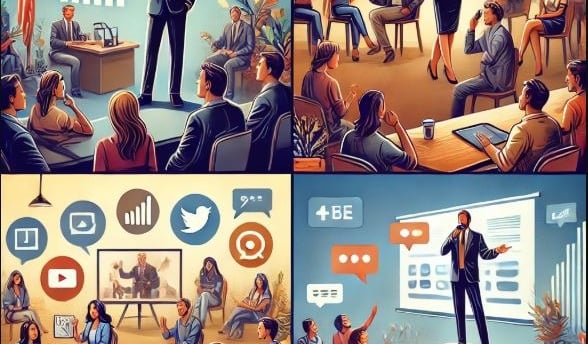Inclusive Communication: 7 Ways to Tailor Your Message for Diverse Audience
This blog provides practical strategies for making speeches and presentations more accessible and engaging for all listeners. It covers key approaches such as using clear language, considering cultural perspectives, and adapting delivery styles to different audience needs. By implementing these techniques, speakers can foster greater connection, understanding, and inclusivity.
Pearl Chivalwala
12/14/20244 min read


For a more in-depth exploration of public speaking techniques, be sure to check out our detailed blog articles on this topic here.
"Good evening, everyone—it's an honour to stand before such a diverse gathering of individuals, each bringing unique perspectives, experiences, and voices to this moment."
Effective communication isn’t just about what you say—it’s about how your message resonates with your audience. In an increasingly diverse world, tailoring your message ensures that it is inclusive, engaging, and meaningful for all listeners. Whether you are a public speaker, marketer, educator, or leader, customizing your approach ensures clarity, engagement, and inclusivity. This article explores the importance of inclusive communication and provides actionable strategies to help you tailor your message effectively.
Tailoring your message to diverse audiences means adapting your communication style and content to suit the unique needs, interests, and backgrounds of different groups of people, ensuring your message resonates with each audience by using language, examples, and cultural references that are relevant to them.
Here are seven key strategies to help you communicate effectively with a diverse audience:
1. Know your audience: A marketing campaign targeting Gen Z may need a different tone and format than one aimed at senior professionals. Conduct thorough research to understand the demographics, cultural backgrounds, interests, and concerns of your diverse audience. Age, gender, ethnicity, socioeconomic status, location, etc., can influence how you frame your message and what examples you use. Example: Instead of assuming everyone celebrates a certain holiday, acknowledge diverse traditions and perspectives.
2. Use inclusive language: Instead of saying “Hey guys,” use “Hey everyone” to be more inclusive. Avoid gendered language, stereotypes, and phrases that might exclude certain groups. By using language that avoids offensive or discriminatory terms, you demonstrate respect for all members of your audience. For a broader reach, avoiding language that might be exclusive to a specific group allows your message to resonate with a wider range of people. When people feel included in the communication, they are more likely to engage with your message and perceive you favorably.
3. Adapt communication style: Adapting your communication style helps tailor a message for a diverse audience by ensuring clarity, inclusivity, and engagement. Different people have unique ways of understanding and processing information based on cultural backgrounds, experiences, and expectations. Adjust your tone, formality, and delivery method to suit different cultural norms and communication preferences. When addressing a mixed-age audience, communication style needs to reflect different generational preferences. Younger audiences may prefer informal, concise, and digital communication, while older generations might appreciate more formal language and face-to-face interaction.
4. Audience segmentation: Divide your audience into smaller groups with similar characteristics to tailor messages more effectively. It helps in allowing for more personalized and relevant communication. Instead of using a one-size-fits-all approach, segmentation ensures that each subgroup receives a message that resonates with their needs, interests, and values. By segmenting the audience, you can address specific concerns, interests, and priorities of different groups, making your message more compelling. When conveying health messages, segmenting audiences by factors such as age, location, or medical condition can enhance effectiveness. For instance, a campaign about the flu vaccine might use different messaging for elderly people (focusing on their risk factors) versus younger, healthier individuals (focusing on community protection). Tailored messages increase the likelihood of behavior change.
5. Visual aids: Not everyone processes information the same way. Visual aids play a crucial role in addressing a diverse audience by enhancing clarity, engagement, and accessibility. Since people have different learning styles, cultural backgrounds, and language proficiencies, well-designed visuals help bridge communication gaps and make messages more inclusive. Visual aids simplify complex ideas, making it easier for diverse audiences to understand key messages, especially when language barriers exist. Charts, infographics, and diagrams can illustrate data-driven points more effectively than verbal explanations alone. Using slides with key bullet points alongside a speech helps reinforce retention for those who learn best through reading.
6. Language access: Consider translation services or multilingual content to reach audiences with different language proficiencies. Language access is essential in conveying a message to a diverse audience because it ensures that everyone, regardless of their linguistic background, can understand, engage with, and benefit from the communication. Providing language access ensures that all audience members, regardless of their primary language, have the same opportunity to receive and understand the message. Language barriers can lead to misunderstandings or misinformation. Using accessible language or providing translations ensures that the message is clear and correctly interpreted.
7. Active listening: By genuinely listening to the perspectives, concerns, and needs of a diverse group, speakers and leaders can tailor their communication to be more effective and respectful. When people feel heard, they are more likely to trust and engage with the speaker. Active listening shows that their voices and perspectives matter. A speaker who acknowledges audience input and responds thoughtfully creates a stronger connection with listeners. In a multicultural discussion, pausing to understand different communication styles helps avoid misunderstandings.
Inclusive communication isn’t just a skill—it’s a responsibility. By tailoring your message to diverse audiences, you foster connection, build trust, and ensure that every voice is valued. Whether you're addressing a boardroom, a classroom, or a global audience, the key is to listen, adapt, and communicate with empathy.
Now it’s your turn! How do you ensure your message resonates with diverse audiences? Share your thoughts, experiences, or challenges in the comments below. Let’s keep the conversation going and make every interaction more inclusive!
Institute Locations -
Global City, Virar (West), Palghar
Kalina, Santacruz (East), Mumbai
Royal Palms, Goregaon (East), Mumbai
Pardi, Valsad (East), Gujarat
Near Ishwar ITI College, Bikaner, Rajasthan
EMAIL: pinnaclespeaking@gmail.com
MOBILE: +91-9022321364
© 2024. All rights reserved.
Contact Us -
@pinnaclespeaking
